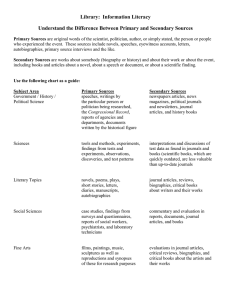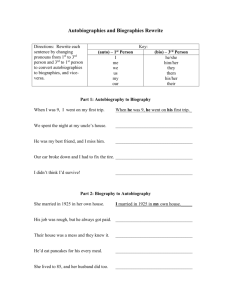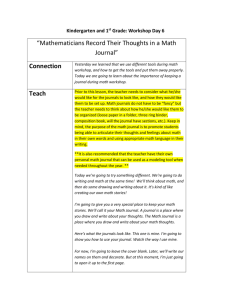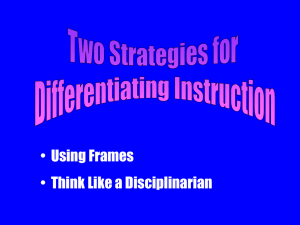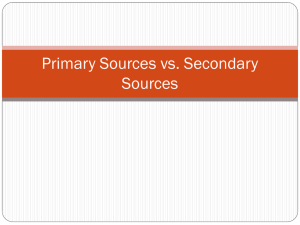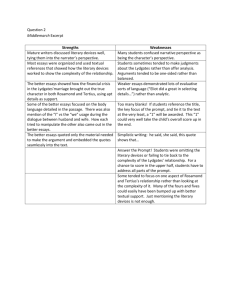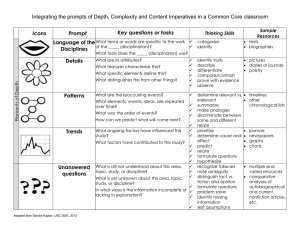Depth and Complexity Chart
advertisement
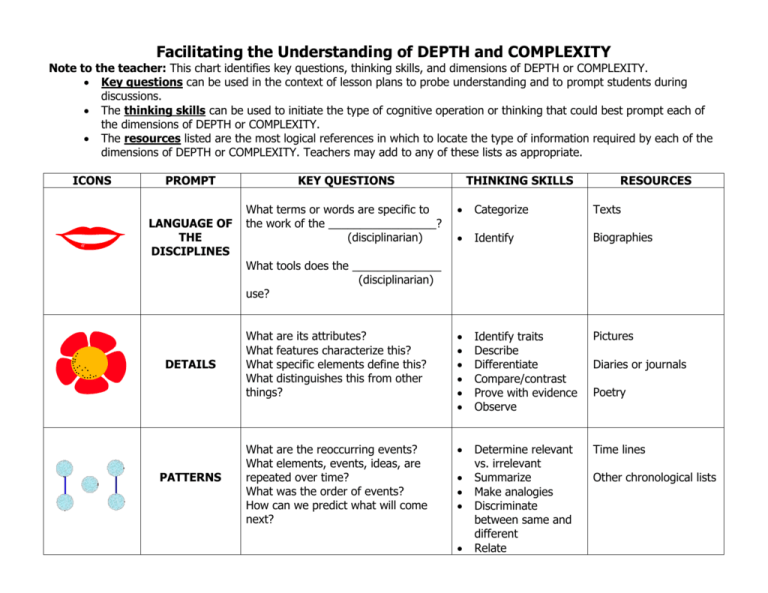
Facilitating the Understanding of DEPTH and COMPLEXITY Note to the teacher: This chart identifies key questions, thinking skills, and dimensions of DEPTH or COMPLEXITY. Key questions can be used in the context of lesson plans to probe understanding and to prompt students during discussions. The thinking skills can be used to initiate the type of cognitive operation or thinking that could best prompt each of the dimensions of DEPTH or COMPLEXITY. The resources listed are the most logical references in which to locate the type of information required by each of the dimensions of DEPTH or COMPLEXITY. Teachers may add to any of these lists as appropriate. ICONS PROMPT LANGUAGE OF THE DISCIPLINES KEY QUESTIONS What terms or words are specific to the work of the _________________? (disciplinarian) THINKING SKILLS RESOURCES Categorize Texts Identify Biographies What are its attributes? What features characterize this? What specific elements define this? What distinguishes this from other things? Identify traits Describe Differentiate Compare/contrast Prove with evidence Observe Pictures What are the reoccurring events? What elements, events, ideas, are repeated over time? What was the order of events? How can we predict what will come next? Determine relevant vs. irrelevant Summarize Make analogies Discriminate between same and different Relate Time lines What tools does the ______________ (disciplinarian) use? DETAILS PATTERNS Diaries or journals Poetry Other chronological lists ICONS PROMPT KEY QUESTIONS What ongoing factors have influenced this study? TRENDS What factors have contributed to this study? What is still not understood about this area/topic/study/discipline? UNANSWERED QUESTIONS What is yet unknown about this area/topic/study/discipline? In what ways is the information incomplete or lacking in explanation? How is this structured? RULES What are the stated and unstated causes related to the description or explanation of what we are studying? THINKING SKILLS RESOURCES Prioritize Determine cause and effect Predict Relate Formulate questions Hypothesize Journals Multiple and varied resources Recognize fallacies Note ambiguity Distinguish fact from fiction and opinion Formulate questions Problem solve Identify missing information Test assumptions Generalize Hypothesize Judge credibility Editorials Newspapers Graphs Charts Comparative analysis of autobiographical and current nonfiction Articles, etc. Essays Laws Theories What dilemmas or controversies are involved in this area/topic/study/discipline? ETHICS What elements can be identified that reflect bias, prejudice, discrimination? Judge with criteria Determine bias Editorials Essays Autobiographies Journals ICONS PROMPT KEY QUESTIONS What overarching statement best describes what is being studied? BIG IDEAS What general statement includes what is being studied? OVER TIME THINKING SKILLS How are the ideas related between the past, present, future? How are these ideas related within or during a particular time period? RESOURCES Prove with evidence Generalize Identify the main idea Quotations Relate Time lines Sequence Text Order Biographies How has time affected the information? Discipline related essays Autobiographies Historical documents How and why do things change or remain the same? What are the opposing viewpoints? DIFFERENT PERSPECTIVES How do different people and characters see this event or situation? Argue Determine bias Classify Biographies Autobiographies Mythologies Legends vs. non-fiction accounts debates
